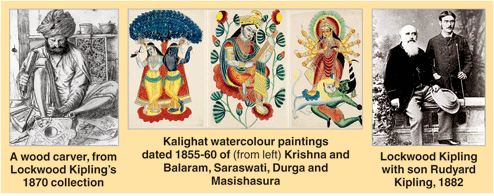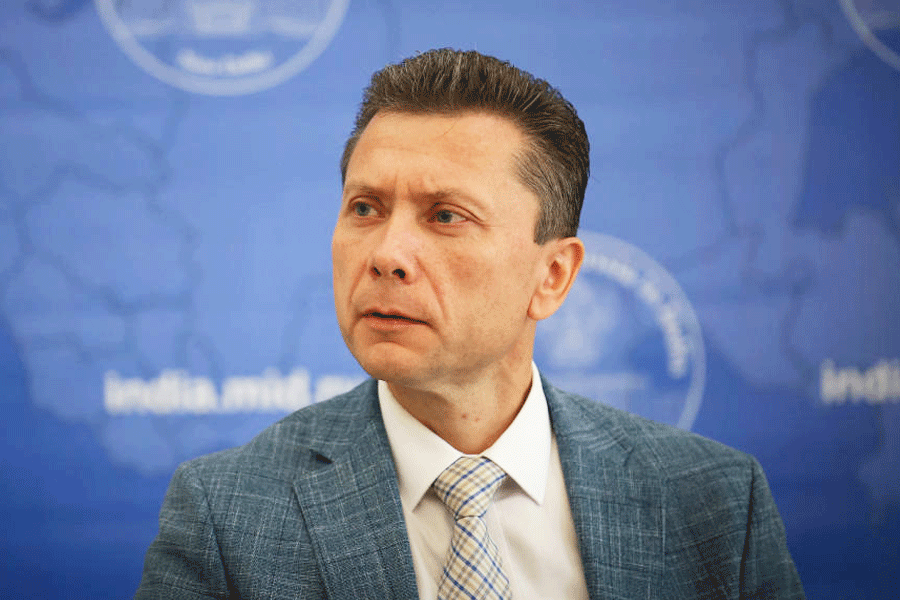May 9: Glimpses of 18th century Bengal were on display at the Victoria and Albert Museum (V&A) in London recently.
A series of Kalighat paintings dated 1855-60, carved pilasters from a chariot of early 18th century Bengal and a medal won by Lockwood Kipling, father of Rudyard Kipling, for curating the Calcutta International Exhibition (1883-84) were among the exhibits at Lockwood Kipling: Arts and Crafts in the Punjab and London from January 14-April 2.
A collaboration between V&A and the Bard Graduate Centre, New York, the exhibition will travel to the US later in September.
Kipling Senior had a strong India connect, having taught at JJ School of Art in Bombay between 1865 and 1874. He also visited Calcutta and curated the country's first international exhibition from December 4, 1883, to March 10, 1884.
He was a huge patron of Indian art and craft and documented the processes of Indian craft-making. Having been associated with the South Kensington Museum, later Victoria & Albert Museum, he designed one of its outer walls with terracotta tiles, an unmistakable influence of eastern India.
The items at the recent exhibition included several pencil sketches by Kipling - during his time in Mumbai - of artisans at work. "The Arts & Craft Movement shaped much of Kipling's career and his visit to the Great Exhibition in 1851 as a 14-year-old was a defining moment when he decided to train as a designer and a modeller. The Indian section was assembled by the British East India Company to secure new markets for Indian crafts and materials. The sophistication of the art and design surprised Victorian audiences. Many of the Indian objects were bought for the collections of V&A founded by Prince Albert as a legacy of the Great Exhibition," said curator Julius Bryant.

A walk around the exhibition revealed such treasures as an 1850 watercolour by Walter Goodale of The Indian Court & Elephant Trappings, a colourful prayer carpet from Ahmedabad, an inlaid marble inkwell from Agra (1850), an emerald and diamond-studded necklace of 1850 and faceted and burnished gold.
Soon after his visit to the Great Exhibition, Kipling senior became an apprentice to a ceramics manufacturer and worked on the architecture of buildings in Gothic revival style designed by George Gilbert Scott. This experience helped him secure his appointment at JJ School.
The Bombay pavilion at the exhibition showcased Kipling Senior's doodles and sketches of Indian stereotypes - the Garpagiri, a wizard and a priest; the Dhobi; the Hajam or barber, the Mahajun or banker and the Mahar, a village servant carrying a bamboo. His sketch of a wood carver, done in Shimla in 1870, is one of the best-known.
Kipling liked to browse local bazaars and fairs for artworks and between 1865 and 1893 he compiled an album of 196 print paintings and drawings along with 37 calligraphic studies, including a series of Kalighat paintings from 1855-60 with a portraiture of Krishna and Balaram, Saraswati.
Also interesting were his decorated plates or dessert plates. A series reproduced scenes Kipling painted for the Punjab Exhibition 1881-82. Titled Nos ennemis intimes (Our Intimate Enemies), these depictions of local servants and craftspeople draw on negative stereotypes of the Indian population and reflect the views of the British ruling class.
Between 1865 and 1900, Kipling curated Indian displays in 28 international cities, including Glasgow, Paris and Melbour ne. On show are pilasters from a 18th century chariot from Bengal displayed at the Calcutta International Exhibition in 1883-84, where they received a bronze medal in the archaeological section. The columns were part of a chariot of the Rajas of Murshidabad. Besides, there was a terracotta tobacco box with the head of a bear climbing a tree stump (1896).
A section belonged to Rudyard and his Pater. The two worked together on the Indian Railway Library series in 1888, where the father designed the cover for the stories. The decorative scheme of Second Jungle Book (1895) was a joint venture. Rudyard fondly fictionalised his father as the kindly curator in Kim (1901).











